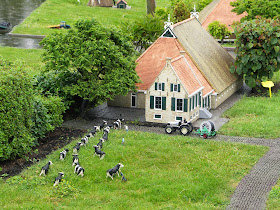Learn to describe the world around your characters with
skill and you will add layers of depth to your story. You won't have to rely on
the amateur’s method of 'telling' to get across how your character is feeling
and thinking about everything, because it will be evident from your rich
descriptions.
Reflect the mood
A country garden can be cast as cheerful and airy or
sinister and dark, depending on what your character is going through and their
mood.
Be specific and use evocative words - Don't just say there
was a bird call. Was it a cheerful greeting or a shrill warning? Don't just say
the woods were dark, were they speckled with cool, relieving shade or dense
with heavy shadow?
Stick to what your Point of View character can see
Even if you're in the third person you should only see whatyour character sees, and tell it from their point of view. The better you can
do this the more real your character and story will feel.
For example, your character:
- can't see something that's around the corner
- doesn't know what other people are thinking
- will see things through their world view – or as I like to put it: to a man with a hammer, everything looks like an nail. For example, if your main character is an accountant, they might view a fight in terms of how much the damage will cost. A Hell's Angel will think it's funny, and a little girl will see the same fight as giants tearing each other apart and have nightmares about it for months. It's not just a fight, it's a hundred things to a hundred people. Be sure you know who your person is.
Use the five senses
Don't worry about prose for a minute, just make list. In
each situation, what can your character:
- See
- Smell
- Taste
- Touch
- Hear
Once you have these things you can either knit them together
into a single descriptive paragraph to set the scene, or sprinkle them
throughout the scene.
Use a picture
Tells a thousand words and all that. Thank whoever it is you
might thank for these things that you are lucky enough to live in an era where
millions and millions of images are available for you to browse at a moment's
notice on the Internet. Centuries of pictures at your fingertips. Moments of
history captured by the deft fingers of expert photographers, the essence of
great leaders echoed in the brushstrokes of master painters, grand landscapes
portrayed in breathtaking art, and crappy photo snaps of cringeworthy chavs.
It's all there.
 And life is always a
thousand times richer than anything you can imagine, so take advantage of it.
If you need to describe a rainy cobbled street in ancient Japan, hunt for a
photo that is the closest approximation. Sometimes you might need several
pictures, and none will get it exactly, but each will add threads and beads to
your tapestry that you might never have found inside your own head.
And life is always a
thousand times richer than anything you can imagine, so take advantage of it.
If you need to describe a rainy cobbled street in ancient Japan, hunt for a
photo that is the closest approximation. Sometimes you might need several
pictures, and none will get it exactly, but each will add threads and beads to
your tapestry that you might never have found inside your own head.
Go there
Even
better than looking at a photo is looking at the real thing. Many leading
authors will go to the places they are talking about (as well as talking to the
people who do what they're writing about, or even better, having experience of
doing it themselves - such as being a detective or being in war). If you have
the time, you should do this too. The power of allowing your senses to
experience the night forest / battleship / penthouse suite cannot be
overstated. Often it won't be practical, but if you get the chance, consider it
a great prize.If you'd like more help writing your novel, find out what makes The Novel Factory so effective.


No comments:
Post a Comment